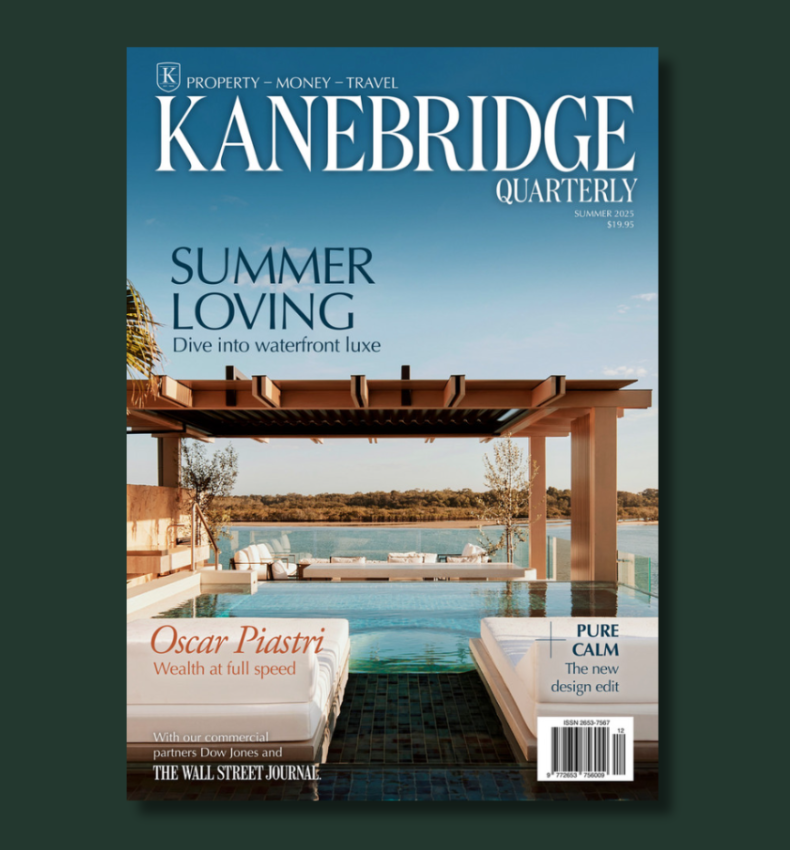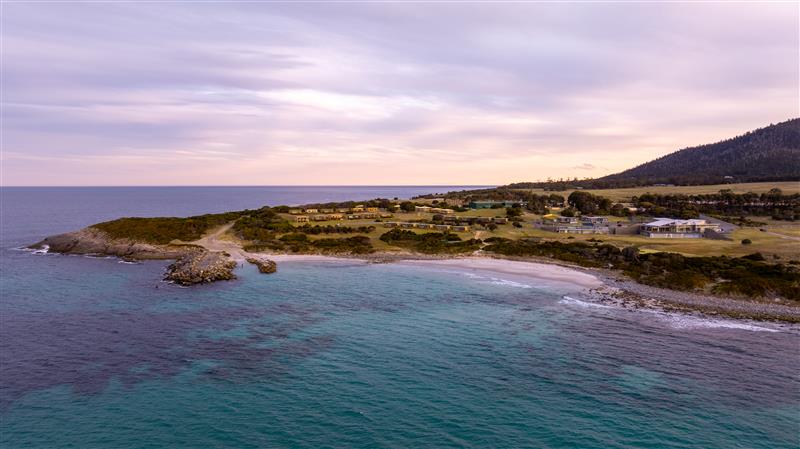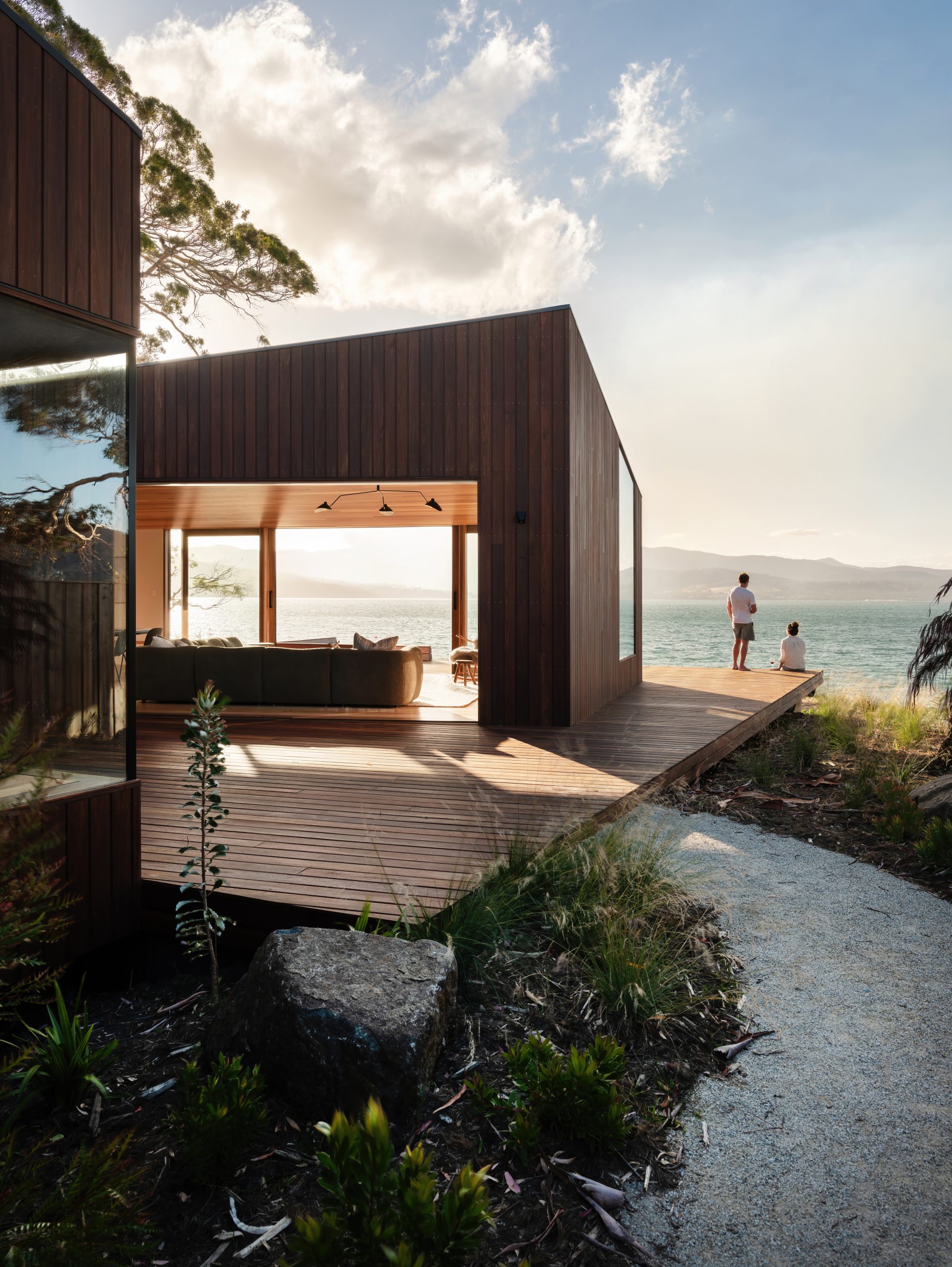RARE TASMANIAN COASTAL ESTATE ON THE MARKET FOR MORE THAN $20 MILLION
A 250-hectare beachfront vineyard, distillery and resort on Tasmania’s East Coast has been listed for sale, marking one of the most significant lifestyle and tourism opportunities to emerge in the State in years.
A landmark coastal property on Tasmania’s East Coast has hit the market, with expectations of more than $20 million for the fully integrated vineyard, distillery and hospitality estate.
White Sands Estate, set across 250 hectares at Four Mile Creek, is being offered by owner-operator John White through Tom Ryan of Knight Frank and Josh Hart of McGrath.
It represents one of the largest privately owned coastal holdings on the East Coast, a region increasingly favoured by both domestic and international investors seeking long-term tourism and lifestyle assets.
The property’s credentials are formidable. It encompasses an operating brewery, distillery and vineyard with a cellar door and tasting room housed within a 3,254-square-metre two-level complex.
Accommodation includes 19 self-contained villas and larger group lodges, alongside multiple event spaces catering to weddings, conferences and corporate retreats. The estate also features manicured lawns, gardens and beachfront event locations with direct private access to Four Mile Creek beach.
Located along the Tasman Highway between St Helens and Bicheno, White Sands occupies a prime position on the East Coast tourism trail, within easy reach of Freycinet National Park, Douglas Apsley and Maria Island. It’s about 90 minutes’ drive from Launceston, making it an accessible yet secluded escape that draws consistent visitor traffic year-round.
Knight Frank’s Tom Ryan said the property’s combination of operational success, large-scale infrastructure and future potential made it an exceptional offering. “An opportunity of this scale simply doesn’t come to the market,” he said.
“We expect strong interest from both domestic and international investors, particularly given the global profile White Sands Estate has developed.”
While already operating as a successful hospitality and tourism venture, the property also offers significant potential for expansion.
“The large-scale site offers multiple future development pathways,” Ryan added. “That includes eco-tourism, resort or residential projects, as well as expanded events and commercial operations.”
McGrath’s Josh Hart echoed that sentiment, describing the listing as a “once-in-a-generation opportunity to secure a fully operational coastal agritourism and lifestyle asset in a tightly held pocket of the East Coast.”
“It occupies a rare stretch of coastline with direct beach access and sweeping ocean views,” Hart said.
“This region benefits from strong year-round visitation linked to nearby icons such as Freycinet and Wineglass Bay, and there are very few large-scale holdings of this nature remaining.”
The East Coast of Tasmania has long been a magnet for tourism investment, prized for its dramatic coastal scenery, growing food and wine culture, and consistent visitor growth.
With strong domestic demand and increasing international visibility, assets like White Sands Estate are becoming increasingly scarce, and increasingly valuable.
The Expressions of Interest campaign for White Sands Estate closes at 2pm AEDT on Thursday, November 20.
The PG rating has become the king of the box office. The entertainment business now relies on kids dragging their parents to theatres.
From farm-to-table Thai to fairy-lit mango trees and Coral Sea vistas, Port Douglas has award-winning dining and plenty of tropical charm on the side.
From the shacks of yesterday to the sculptural sanctuaries of today, Australia’s coastal architecture has matured into a global benchmark for design.
In the land down under, the beach is in our DNA. So is it any wonder that Australian architecture is leading the world in luxury coastal design?
With about 85 per cent of our population living within 50 kilometres of the coastline, we’ve perfected the art of the beach house. Yet over the past two decades, there’s been a sophisticated shift in the traditional coastal cottage.
The residential revolution that has washed over our most valuable waterfront locations has replaced the original weatherboard “shacks” by the sea with a contemporary design movement shaped by admiration and respect for the natural environment.
No longer simply about the view, today’s coastal architecture is about creating beautiful homes that perform seamlessly in an increasingly volatile climate while meeting the rising tide of high-net-worth buyers who want it all.
From infinity pools to wellbeing spaces that connect with nature, one-time weekenders have been transformed into permanent escapes, providing year-round indulgence.

An island home
Belgian-born, Tasmania-based architect Lara Maeseele believes the quintessential coastal home has become a finely tuned instrument. With more vacant land to experiment with, and lower entry prices, she says the Apple Isle is perfectly placed for architects and homeowners to explore the new-age beach house.
“A highlight in Tassie is you can find these amazing vacant blocks on the coastline, and still be blown away by the unexpected views,” she says.
Having studied in Belgium and worked in London, Maeseele brings a northern European minimalist sensibility to the Australian beach house.
“Our way of life is so complex. When we get home, it’s nice to slow down, to declutter and find some peace and quiet.”
Nebraska House on Bruny Island took home the 2025 HIA Tasmanian Home of the Year and earned a commendation at the Houses Awards, but Maeseele still affectionately refers to her design overlooking the D’Entrecasteaux Channel as a “shack.”
“What we tried to do was make sure that from the foreshore, it was kept small and consistent with the neighbouring properties, and that’s the luxury element that I see in the shack. It sits quietly in its setting.”
With a water backdrop from most rooms, she says the ocean was a primary player when designing the house, but light was just as important for the clients.
“Both the western and eastern elevations slide wide open so it feels like a bit of an umbrella,” she says. “Then in winter, it’s fully insulated and glazed. When the sun sets, you have the most beautiful evenings, feeling cosy and sheltered while watching the wind and water outside.”
True to her European roots, Maeseele believes that when it comes to aesthetically pleasing and functional coastal design, the less-is-more approach should drive every project.
“We’re on an island, so we’re very aware any build leaves an impact,” she says. “We chose lightweight materials so, in the end, the house could be dismantled and the timber reused.”

Thriving by the sea
Sydney architect Jon King, who has designed both beach houses and boutique hotels, says the new generation of coastal design is a balancing act between luxury and environment.
Even in today’s dazzling designs, he believes comfort should still overshadow spectacle.
“If you’re going to make an exceptional beach house, it has to adapt. It needs to be beautiful when the sun is shining and the whales are jumping out of the water, but the next day it needs to withstand horrendous southerlies and wild storms,” he says.
“The material choices are vital because they need to look great, but last in that salty environment and in extreme winds and rain.”
What was once the domain of fibro cottages has developed into a sea of enviable, state-of-the-art designs.
“For a long time, we lived simply in beach environments because the land was cheap and our buildings were unsophisticated. But now, living on the coast has become coveted, even fetishised. People are making statements through architecture, and that changes everything.”
He says that in an effort to connect with nature, the temptation can be to build with vast walls of glass to capture the ultimate panorama, but subtle design can be more successful when it gives the dramatic backdrop a curated cameo.
“Most coastal locations are suburban in nature with small blocks and neighbours either side, so you can’t always get the view you want,” he says.
“But you can frame it beautifully rather than opening everything up to the elements.”
Cheyne Fox of White Fox Gold Coast, who has recently listed one of only two houses on Hayman Island in the Whitsundays, agrees that Australia’s coastal homes are unparalleled.
“Gone are the days when people wanted their properties to stand out and look at odds with the surrounds. Today’s luxury designs are very much about fitting in,” Fox says.
The Residence at Hayman spans three levels and offers more than 1,400 square metres of internal and external living space.
Designed by the late, internationally renowned architect Kerry Hill, it also features breezeways, terraces and an infinity pool designed to embrace the subtropical environment.
“When you get to Hayman Island, you get calico bags. There are no plastic bottles or even cars. There is a true respect for the environment, being so close to the Great Barrier Reef. And as such, the architecture reflects that ethos.”
She says high-net-worth buyers will pay top dollar for such indulgent and considered coastal designs.
“This is a once-in-a-lifetime proposition for a purchaser, but also a once-in-a-lifetime proposition for an agent.”
Read the full story here.
Australia’s housing market defies forecasts as prices surge past pandemic-era benchmarks.
A cluster of century-old warehouses beneath the Harbour Bridge has been transformed into a modern workplace hub, now home to more than 100 businesses.




















